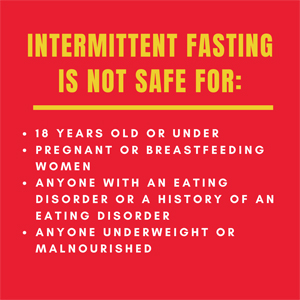|
Intermittent Fasting 101
|
 What is Intermittent Fasting? What is Intermittent Fasting?
Also referred to as IF, intermittent fasting is not a diet; instead, it's an eating plan based on consuming food and then fasting over specific predefined periods. During the eating periods, it's recommended to achieve normal eating patterns and calorie intake. Eating periods are followed by a fasting phase where only liquids such as water, sparkling water, unsweetened tea, coffee and broth.
Origins:
The proponents of IF point to the fact that our ancestors did not always have three meals per day. Early humans were hunters and gatherers and would experience both periods of abundance as well as scarcity. Based on the belief that our bodies were originally built for the hunting and gathering lifestyle and operate more efficiently in this environment.
Health Benefits:
More and more research is beginning to emerge on the potential health benefits of IF. Some of these benefits include: improve cholesterol, blood pressure, better blood sugar, and insulin levels. Intermittent fasting is also associated with a decrease in risk factors for Alzheimer's. More research is needed, but scientists are looking at using intermittent fasting as a way to treat cancer cells.
How to IF?
This is where the world of intermittent fasting has gotten a little confusing and can feel overwhelming. Do a Google search on IF, and you're likely to find a variety of approaches on intermittent fasting. For simplicity purposes, this newsletter is going to focus on the two most common ways to practice intermittent fasting:
- Time-restricted fasting: you have a 6 - 8-hour window to eat and leaving 16 - 18 hour period to fast each day.
- 5:2 intermittent fasting: you eat regular meals five days out of the week, but two days a week, eat only one moderate-sized meal.
The key to intermittent fasting is not to undereat or overeat during the feeding windows, but instead fuel and nourish your body with wholesome and nutrient-dense food. Intermittent fasting is not cutting out food groups like carbs or fat but instead modulating when you are eating.
|
|
|
Is it safe?
|
 According to a recent issue of the New England Journal of Medicine, intermittent fasting is a legitimate option that might be worth considering. However, some people should not fast. According to a recent issue of the New England Journal of Medicine, intermittent fasting is a legitimate option that might be worth considering. However, some people should not fast.
If you are experiencing or have a history of any of the following conditions, you should not practice intermittent fasting:
- Under 18 years old
- Pregnant or breastfeeding women
- Eating Disorder
- Underweight or malnourished
- Elderly
Before fasting, always discuss with your physician and registered dietitian if you have any of the following conditions:
- Type 1 or 2 diabetes
- Gout
- Reflux
- Taking prescription medications
|
|
Featured Recipe
Chocolate-Dipped Bing Cherry Treats
|
 There is a lot to celebrate in February, including Heart Health Month, Valentine’s Day National Cherry Month, and National Chocolate Lovers Month. With so many things to celebrate, I’m sharing this simple recipe that is sure to make anyone’s heart smile! There is a lot to celebrate in February, including Heart Health Month, Valentine’s Day National Cherry Month, and National Chocolate Lovers Month. With so many things to celebrate, I’m sharing this simple recipe that is sure to make anyone’s heart smile!
Recipe by: California Cherries
Cherries and chocolate are a classic combination. This version is as simple as it is elegant and delicious.
Ingredients
- 1 to 2 pounds fresh California Bing cherries
- 6 oz. semi-sweet chocolate chips
Ingredients
Line a baking sheet with aluminum foil. Heat chocolate over medium heat, stirring often with a wooden spoon until melted, about five minutes. (Note: Use a double boiler. Or fill a saucepan half full with water and place chocolate in a small, deep heatproof bowl that fits snugly on the saucepan, but does not touch the water.)
Wash cherries with stems on and let dry. Optional pitting instructions: Using a cherry pitting device, carefully remove the pit going through the cherry cross-ways rather than from top to bottom. This will allow the stem to remain intact. The hole in the middle of the cherry will be covered with chocolate when dipped.
Carefully pick cherries up by the stem and dip just over half-way into the melted chocolate. Let excess chocolate drip back into the pan or bowl.
Place on an aluminum-lined cookie sheet and set in the refrigerator until the chocolate has set, about 15 minutes.
Serve immediately or store in an airtight container in the refrigerator for up to 3 days.
Nutritional Information:
(per 4 cherries) 33 calories, 1 gm fat, <1 gm saturated fat, 5.6 gm carbohydrates, 0.5 gm fiber, 0 gm protein,
|
|
|
Be Inspired
|
|
"Live less out of habit and more out of intent."
- Unanimous
|
|
|
About SO Nutrition
|
 Stephanie Leipprandt Ouellette, MBA, RDN, LD
Stephanie Leipprandt Ouellette, MBA, RDN, LD Stephanie has been working in the field of nutrition and dietetics since 1995. She earned a Bachelor of Science degree in Dietetics from Michigan State University, completed an Approved Pre-Professional Practice Program at Western Michigan University and earned a Master of Business Administration from Baker College. She’s been a Registered Dietitian Nutritionist since 1996 and licensed in Texas since 2007. In 2008, Stephanie earned her certification in Childhood and Adolescent Weight Management. Stephanie has extensive clinical & managerial experience, both in corporate settings and in the community. Now she wants to share her knowledge with you, because most (if not all) nutritional habits begin at home.
Stephanie and her family reside in Katy, Texas
|
|
| |
Copyright © 2020 Customized Nutrition Newsletters, All rights reserved.
|
|
| |
|
|